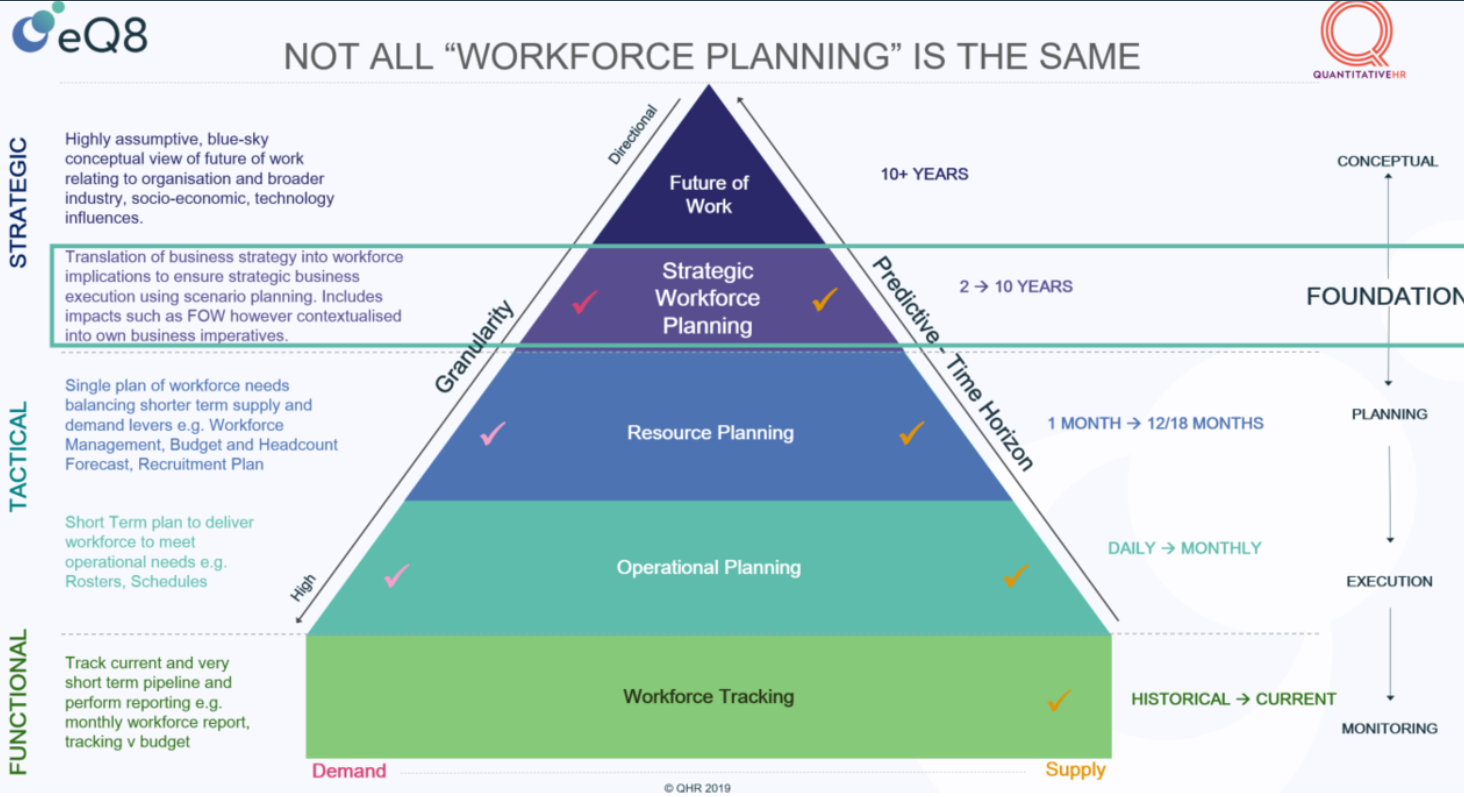
Ahhh, Strategic Workforce Planning, may I please call you by another name?

Ahhh, Strategic Workforce Planning, may I please call you by another name? After explaining you for so long, I feel the time has come my misunderstood friend. You need a rebrand. You see, it’s not you – it’s them. People just don’t get who you really are. Some think you are rostering, workforce management, project management, budget planning or Future of Work projections. Others believe they can put their fingers in the air and qualitatively guesstimate the future size and shape of their workforce, and call it by your name. Many think you are too hard, that you are just not worth it or that you are some passing fad, like fidget-spinners. I know that you are the key to connecting people to organization purpose, that you are the true path to transformation and organizational effectiveness. The market just doesn’t get you. They just don’t DO you.

OK, so before people think I have lost my mind (too late?) I will stop the conversation with SWP, but really we need to talk about SWP. The thing about SWP is that yes, it is about the workforce – but that doesn’t mean it is another item in the “best-practice toolkit” or laundry list for HR. SWP defines that list in the first place! And not just for HR, but for the whole business, who are relying on the capabilities and skill of the workforce to deliver its transformation, digitisation or growth agendas.
Acceleration in the pace of change coupled with our experience of shocks (GFC and Covid destroyed many of our existing assumptions) shows the fallacy of rolling restructures and so-called agility. It is no good to just react quickly, we must look forward to navigate the ever changing world and respond coherently and optimally, which comes with SWP and its scenario planning.
Because the organization IS our workforce, and the workforce is the key execution vehicle for our purpose and strategy. It is the workforce that now must re-pivot, re-imagine and re-emerge as the who, what, where, how and even why has changed. The right workforce to both do and decide is critical for all organizations (and as we already know, their biggest asset, largest cost) and SWP is the way to optimise the workforce – so why so misunderstood? Why so not done?
Let’s take a look at the common reasons we come across . . .
“The benefits are unknown for the time/cost of SWP”
The impact of SWP is HUGE. Unlike many initiatives around the workforce, which can deliver cost optimisation, SWP goes even further to deliver top-line impact – think Sales growth and customer retention. Sierra-Cedar puts companies who do SWP at an average of 10% higher business outcomes such as sales per employee, ROE or profit per employee. Plus 12% higher talent outcomes such as engagement, succession and retention. Not optimising the workforce, too much of the wrong capabilities or wrong cost base – significant. Missing business goals, milestones or customer demand . . . catastrophic!
“SWP is not as important as my other stuff”
For too long, HR has been asking for the “seat at the table”. Then often sitting in that seat, our leaders have just been good listeners. The function’s value has been to optimize processes to carry out business directives – what a business partner! But are we bringing our own, commercially-driven, outcome-focused viewpoint to shape strategy, transformation and direction? The answer is often no. Did you know that SWP is now firmly on the Board agenda for many organizations? SWP enables answers to key Board questions:
Digitisation and transformation on the agenda? McKinsey has cited lack of requisite skills and lack of leadership alignment as massive blocks in achieving successful transformation, both of which can be overcome through SWP.
“I already am doing SWP”
Are you? Really? For starters, SWP is complex. Sierra Cedar says it is “the most complex analysis efforts undertaken by HR functions.” It is true, it is really complex. This is because there are just so many moving factors that need to be brought together and integrated properly to deliver this. For example, we have:
How on earth do you bring all of that together? SWP. That is because the bringing together of all of these elements needs to be done quantitatively – unfortunately conceptual discussions stay just that – conceptual - rarely do they incite action. SWP is the only way I have seen companies be able to effectively and proactively navigate the vast and accelerating change we are all facing. You need the ability to bring all of these elements into dynamic scenarios in order to make the right decisions.
And by the way, Excel does not achieve this (refer below . . .)
“Finance has it covered”
OK, if you have looked at my LinkedIn profile, you will see I am a Chartered Accountant who started my career in Finance. While partnering with Finance is essential, for the majority of organizations we see running “workforce planning” through their finance teams in isolation, the focus is very much on getting a financial view of the workforce only (i.e., budget and cost focused). The insight into capabilities, skills, job neighbourhoods and the whole employee lifecycle is usually absent. Oh, and the fact that there are actual human beings attached to those numbers . . .
“Strategy has it covered”
Similar to above, the lens with which other functions view the workforce can be limited. This is not an uncommon dynamic. It is very typical for leaders (and humans in general) to view the world through their own lens. Hence, we often see strategies set with an assumption that the requisite workforce will just materialise and appear right as needed, with leaders unclear on what any given strategy actually means for their part of the business aka "Strategy Struggles".
One of my often (too often if you ask my co-founder Chris) quoted faves from Joseph Jaworski in Synchronicity “a managers’ inner model never mirrors reality…it is always a construct. The scenario process is aimed at these perceptions inside the mind of a decision maker”.
I have been in rooms in large listed companies where the dialogue and scenario planning of SWP has uncovered serious misalignment in business direction between CEO, COO and CFO and then brought them back together again. The scenario planning process of SWP is critical in creating alignment amongst leadership and driving superior decisioning for business success.
“I have it covered another way”
There are some great data sets out there. Really cool. All about the Future of Work, automation, the robots are coming . . . or not (if you are really special and your role is safe!) These range from online tools - you can enter your job into and see whether you need to chuck it all in and become a Maxillofacial Surgeon (apparently low robot risk, go figure) - right up to super pretty, complex and comprehensive datasets. The problem is that is often missing your own organizational context and is only a narrow sliver of the picture – refer “I am already doing SWP” - where you will see that there are whole set of other puzzle pieces stuck to the bottom of the coffee mug and heading for the sink.
“I can get by with Org Redesign/Restructures”
SWP is about being proactive. We are not talking about the organizational restructuring that companies have been doing (annually, quarterly, monthly, more!?!?) for decades. The problem with org redesign/restructures is that they are inherently reactive, usually top-down and often short-term fixes. How many of us have lived through repeated restructures to see the following:
“I haven’t been asked to do this”
We hear this all the time. Most don’t ask for it because many don’t understand it in the first place (refer paragraph 1), let alone think HR can do this. It is emergent, so many have not seen it done before, but they are asking the questions that only SWP can answer effectively.
The problem is that this stuff is critical. As above, discussions around lack of skills and future of work are firmly embedding themselves into C-Suite and Board agendas. SWP is THE key recommendation by the World Economic Forum to deal with the Future of Work and the “re-skilling revolution”. McKinsey puts organisations that use scenario modelling as 2.4x more likely to have successful digital transformation, with those having a dynamic and co-owned plan 2.9x more likely. SWP delivers this!
This is why we are increasingly finding SWP being taken over by COO, CIO or whole new functions dedicated to transformation. What C-Suite executive would not want to drive this kind of an impact? HR, if it realises its full potential, is the rightful leader of this conversation as the custodians of the workforce, but it must act now.
“We will do it . . . later” [or “We’re not ready”]
Yes we all are busy, busy, busy, and caught up in the urgency of what is front of us and will get to that other “planning for the future” stuff later. This has never been more prevalent then right now – where we certainly are in the midst of change like we have never seen before. But what if later is too late? Your business model is outdated, you haven’t been able to innovate and change and adapt? (think Warner Brothers, Kodak, Blockbuster, Toys R Us, Borders et al.)
You have made the wrong short-term, reactive decisions that have actually damaged your long-term viability – for example blanket workforce reductions across the org, without actually knowing which skills/capabilities are going to be key enablers for your critical Customer Experience agenda next year.
You may think this is not the role of HR, or can be written off due to external forces “outside our control”. But think again. Who drives innovation? Who drives and executes change? Who transforms and adapts? People. Who are people? The workforce.
“I can’t because I don’t have the right… [insert reason]”
Data. People. System. Planetary Alignment…whatever the reason, it’s just an excuse. The reality is, there is never perfect data; you will be waiting forever. People with a good understanding, let alone experience in true SWP are like unicorns, and if you find them – everyone else wants them too. As for systems, until recently, I have been doing SWP for years in cobbled together (one well-known industry expert calls them “home-made”) solutions which has still been effective. The problem with systems is that the home-made versions invariably start with good old excel (which don’t get me wrong I LOVE) which is inherently unscaleable, unsustainable and does not really break down silos effectively for cross-organisational views. Or many system alternatives to home-made options may be called SWP, but really just look like “excel in the cloud” (give or take some functionality) and/or do other workforce planning types (refer main image).
Conclusion
Until now… you knew it was coming right? You don’t have to wait for that perfect data, team or hand-written invitation to start. You can enable your organization to achieve its goals, drive the right conversations, support true agility and optimize costs – not to mention increase social responsibility! There is now one integrated SWP platform. eQ8 enables you to connect your people to purpose, solving all the excuses and problems. Well, maybe not planetary alignment – if mercury is in retrograde, you’re on your own!
So for now, my dear SWP, I will continue to call you by your name – I just don’t think they could handle another corporate jargon term right now. But I sure do hope they see that you are THE critical enabler of transformation and organisational effectiveness before it is too late . . .
For more information visit www.eQ8.ai